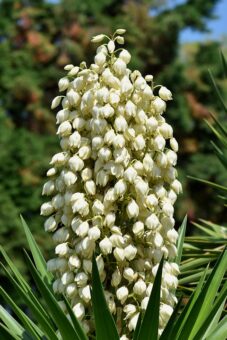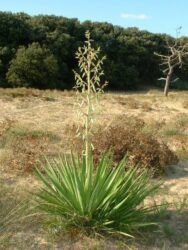In this article, we will discuss how to grow the beautiful architectural leaf plant of Yucca in containers. They tend to have rosettes of stiff, sword-shaped green leaves that can also be variegated. The leaves can be very sharp coming to a point in Yucca gloriosa. This is why you may need to be careful if you have young children, as they can cause serious injuries. The common name of Spanish dagger is well warranted.

Yucca has many common names depending on where you are from and what species is growing. This includes Yucca, Spanish Bayonet, Spineless Yucca, Adam’s needle and thread, or Spanish Dagger. What must be remembered is that most species of Yucca are hardy and some can take temperatures as low as -15 degrees Celsius, whilst others will die if the temperature drops below -5 degrees Celsius. They are not an easy plant to keep happy outdoors.
They are either evergreen perennials, shrubs, or trees with rosettes of stiff-sword shaped leaves, either green or variegated. In summer to autumn tall panicles of white, bell-shaped flowers appear.
As the plant grows the lower leaves die back, exposing a trunk. You will have all the leaves at the top and a trunk at the bottom, which increases in size as the lower leaves die.
For outdoor growing Yucca gloriosa and Yucca filamentosa are the ones to go for. The other two yucca species of Yucca elephantipes and Yucca aloifolia can be grown outdoor but you will need to offer winter protection by having them in a conservatory or greenhouse. As they can be big and heavy, this can be problematic. All Yuccas require full sun and good drainage.
HOW TO PLANT A YUCCA IN A CONTAINER
First, buy a container that is large as possible (a tall half-barrel will do) and make sure it has plenty of drainage holes at the bottom. Fill a layer of 5cm of gravel at the bottom of the container as Yuccas can suffer from root rot if they are left in soggy compost.
Next mix 30% by volume of horticultural grit with 70% by volume of good quality, multipurpose compost.

Dig a hole twice the size of the root ball it came in the original container and place the plant in at the same level as it was in the original container it came in- no higher or no lower.
Backfill with the growing media and add more if any gaps remain. Firm the plant in and water well to allow the potting mix to settle. You will need to water regularly during spring and summer, and when 5cm below the top of the surface of the compost feels dry to the touch. When you do water make sure that you do it thoroughly and that any excess water is allowed to drain through the drainage holes.
Make sure it is placed in a location that is south-facing and in the brightest location possible.
OVERWINTERING IS CRUCIAL
Overwinter tender yuccas will need to be moved indoors, but I do not recommend that you do this as they are big plants and difficult to move. Instead, I recommend that you buy some of the more hardy varieties.

Yuccas do not need much in the way of pruning, as all you need to do is remove dead and damaged leaves and spent flower spikes. The yucca may take many years to flower, so be patient and eventually, the plant will reward you. You can save the seeds that are produced by the flowers and sow them to propagate new plants.
Sow seeds in spring at 13 to 18 degrees Celsius for hardy yuccas, and 19 to 24 degrees Celsius for tender species. The seeds will need to be sown after they have been soaked in water for 24 hours, as this will aid and speed up germination.
PESTS AND DISEASES
The good news is that the plants do not suffer from that many. Aphids are attracted to the flowers and slugs and snails may nibble on the leaves.
One problem you may notice is that the leaves may develop brown spots, often a sign of fungal disease. This can be hard to deal with but you can try an ornamental systemic fungicide to see if it prevent this from happening. Otherwise, you will have to live with it.
VARIETIES TO GROW
The hardy varieties that can be grown outdoor include:

Yucca elephantipes ‘Jewel’ has spectacular green and gold variegated foliage makes this a striking specimen plant for the patio or conservatory. The stiff, sword-like leaves cover its woody, upright stems creating an evergreen focal point that remains reasonably compact.
Yucca filamentosa is a small shrub that has clump-forming, dark green leaves with curly filaments. In late summer, cream flowers appear on panicles.
Yucca gloriosa (Spanish Dagger) is a 2m tall medium-sized shrub. It has a single stem with viciously sharp, stiff blue-green leaves. In late summer and early autumn, creamy, purple-tinged flowers appear.
Yucca gloriosa ‘Variegata’ is similar to its normal variety but instead has stiff, sharp, striped green and creamy yellow leaves. From summer to autumn panicles of creamy–white flowers appear.
Yucca flaccida ‘Ivory’ is a tall, clump-forming, stemless shrub that has dark green leaves. In middle to late summer, pure white flowers are produced.
Yucca flaccida ‘Golden Sword’ is similar to its cousin but has lance-shaped leaves that drop to a point. The leaves have a central stripe that is creamy-yellow mixed with green at the edges. In late summer, creamy-white flowers ate born on long panicles.
CONCLUSIONS
In this article, we have discussed how to grow yuccas in containers. As you can see that they are not difficult to grow, as long as you get the container’s drainage right. You have plenty of possible varieties to which you can grow outdoors in the UK.
They have elegant leaves that do not have to be green as they can be variegated. All this and they produce panicles of tall flowers that add to the look in late summer to early autumn.
If you have any questions or comments that you wish to make on growing yuccas in containers, please do so in the comment box below.
Happy Yucca growing.
